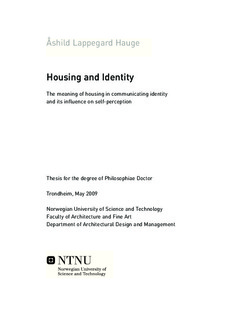| dc.description.abstract | The main aim of this PhD project has been todevelop knowledge about the relationship between housing and people’s identity. The findings are presented in three journal articles:
Article 1 is theoretical, and aims at finding analytical tools for the subject of housing and identity. It evaluates the “Place Identity” theory (Proshansky, et al., 1978, 1983, 1987) as diffuse, but the “place identity” term as relevant. The Social Identity theory (Tajfel, 1981, 1982) and the Identity Process theory (Breakwell, 1983, 1986, Twigger-Ross et al., 2003) are better tools for research on the physical environment’s effect on identity. Place identity can be seen as one of many identity manifestations, and represents identity manifested through physical environments and objects. A schematic model is presented that treats place identity as one of many levels at which a social identity category (such as social class) may manifest itself. The model aims to integrate the place identity concept into Social Identity theory.
Article 2 explores associations and attitudes people have to the subject of housing and identity. The results are based on case studies of a high-priced and a low-priced neighbourhood in Trondheim, including a questionnaire and 18 qualitative interviews. The survey showed that 40% of the respondents were aware of their dwelling reflecting who they are. Respondents in the high-priced neighbourhood had a greater awareness of this association. Only 19% thought it was important. Qualitative interviews showed that people may be divided into three groups when it comes to different interest and awareness of the dwelling as communicating identity: 1) People who have not thought much about it; 2) people who have thought little about the issue, but are very interested in the subject when asked about it; and 3) people who discuss the issue spontaneously and are concerned about the matter. Younger people found the subject more natural and obvious than older people. The interviews showed that dwelling is experienced as information about personality and taste, interests, life phase, social status, and relationships. Cohort, attitudes towards self-presentation, and the sensitivity of the subject affect people’s attitudes towards the dwelling as identity communication.
Article 3 explores the meaning of architectural qualities for the identity of formerly homeless criminals and drug abusers. It describes a case study of a social housing project where the architecture was intended to positively affect this group of residents. Interviews with initiator, employees and residents were conducted, as well as studies of statements by the jury of the Norwegian State Award for Building Tradition 2007, and presentations of the housing project in the media. The residents and employees were in general satisfied with the housing situation. The residents appreciated and took care of architectural qualities, and the environment inspired them to protect it. They were proud of their apartments, and had more contact with their families and children as a result. The social network expressed hope and pride in them because of an attractive housing situation. Some residents saw architectural details as symbols of a crime- and drug-free life and identity. This may have significance for consolidating a new identity as nondrug-abuser, and may further have significance in motivating change. The study also gives an example of how positive associations with the building may change according to life situation. The symbolic content of objects and environments is under constant influence of situational changes and social interaction.
Overall conclusions: Based on the empirical research presented, it appears that housing influences personal and social identity in two ways: through the associations that residents make with location, exterior and interior, and through physical solutions that facilitate behaviour and social interaction. These relations are not dependent on the physical environment alone, but are also influenced by context, process and situation. Breakwell’s Identity Process theory illustrates these mechanisms through the principles she sees as central for people’s identity in western culture (self-esteem, distinctiveness, self-efficacy, and continuity), and the way housing contributes to these (Breakwell, 1983, 1986, Twigger-Ross et al., 2003). Methodological experience shows that the topic requires sensitivity in the formulation of questions, and that qualitative methods give the informants opportunities to moderate and explain their answers. Interdisciplinary, longitudinal studies and context awareness are important for further research on the topic. Housing may be used as a strategy or a tool to positively affect identity, motivation, and future hope among people in vulnerable life situations. Location and architectural solutions must be considered together with context and process to strengthen housing quality as a contribution to a resident’s positive self-perceptions.
| nb_NO |

